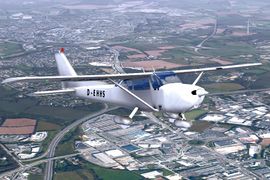Brest

Brest (pronounced [bʁɛst] in French, [bʁest] in Breton) is a city in the Finistère department in Brittany in northwestern France.
Located in a sheltered position not far from the western tip of the Breton peninsula, Brest is an important seaport and naval base. The 1999 census recorded 303,484 inhabitants of the Brest metropolitan area, while the population of the city itself was 139 342, according to the 2016 census. Although Brest is by far the largest city in Finistère, the préfecture (capital) of the department is the much smaller commune of Quimper while Brest maintains some administrative responsabilities as a sous-préfecture.
Brest is best-known for its Pont de Recouvrance (a massive drawbridge 64 m/210ft high), the military arsenal and the Rue de Siam (Siam Street). The Castle and the Tour Tanguy are the oldest monuments of Brest.
The city is near strategic military installations such as l'Ile Longue (Long Island), an active nuclear submarine base. However with the retirement of DCNS naval buildings, military presence is declining.
The Musée de la Tour Tanguy houses a collection of dioramas that depict the city of Brest on the eve of World War II. The Musée de la Marine de Brest contains exhibits which outline Brest's maritime tradition, as well as an aquarium, the Océanopolis marine centre. The city also contains a notable botanical garden specializing in endangered species, the Conservatoire botanique national de Brest, as well as the Jardin botanique de l'Hôpital d'Instruction des Armées Clermont-Tonnerre.
The city of Brest doesn't have much historical architecture, apart from a few select monuments such as the Castle and the Tour Tanguy. This is due to heavy allied bombing during World War II, in an attempt to destroy the submarine base the Germans had built in the harbour. The town was hastily rebuilt in the 1950s using a large amount of concrete. In Recouvrance, the left bank of the town, there remains an authentic street of the 17th century, Saint-Malo Street.
A few kilometres out of town, there are more impressive landscapes, from sandy beaches to grottos to tall granite cliffs. Sunbathing, windsurfing, yachting and fishing are practiced in the area. Brest was an important warship producing port in the Napoleonic wars. The naval port, which is in great part excavated in the rock, extends along both banks of the Penfeld;
FlightGear scenery
Currently it's one of the only two places in FlightGear with photorealistic scenery under CC-BY-SA licence, thanks to the Brest Metropole Oceane aerial pictures.
There is also a big work being done on the countryside around Brest to include all important VFR interesting points (such as windturbines, lighthouses, etc...), and also on airports layout and content like Landivisiau Naval Air Base (LFRJ), LFRB, LFRL. This work is available via Terrasync. Please note that this work is licensed under CC-BY-SA (Brest Métropole Océane). Make sure you ref to them if you post pictures or videos.
How to do it ?
If you want to try to achieve the same result for another place, try the following hints:
- Apply patch to SimGear and shaders.
- Download Geotiffs with desired area (for instance : here).
- In Qgis crop them by tiles size (depending of lat/lon) and stretch it to ^2 size in The Gimp.
- Convert it to dds (like 942058.dds) and place it next to your .btg tile.
External links
- Download photorealistic Brest (from a mirror)
- Read this topic for more on the photorealistic work
- The way it currently looks
- Flying over Brest with the special scenery texture (720p) - October 02, 2010